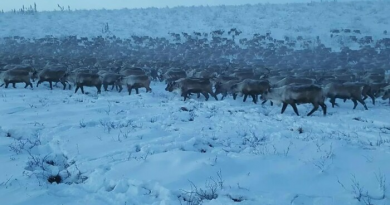On Barents roads, no slowdown in death accidents

Despite improved road standards, lethal car accidents continue to haunt travellers in the Barents Region. More than 600 people will die on regional roads this year.
Talking to her regional government this month, Murmansk Governor Marina Kovtun expressed major concern about the high number of people killed on regional roads. Figures from the road authorities show that a total of 60 people were killed in traffic accidents in the first nine months of the year, a 53 percent increase compared with the same period in 2013, the Murmansk government informs.
That increase comes as significant sums are being invested in regional roads. Over the last few years, Murmansk Oblast has upgraded major parts of its road network and the M18 (E2015) road from the Norwegian border and further towards St Petersburg is now in a very good condition.
”There is a war going on on our roads: healthy people are dying, people full of energy who otherwise could have lived happy lives […]”, the governor said, adding that thorough analysis now is required in order to turn the trend.
The situation in Murmansk is not unique. After several years of decrease, the road death tolls in many Russian regions now show only very modest, if any, downturn.
Arkhangelsk Oblast
As shown by figures from Patchwork Barents, the situation is the worst in Arkhangelsk Oblast, where 193 people died in traffic accidents in 2013. In Karelia, the situation is likewise worrisome. Despite its far smaller population than both Arkhangelsk and Murmansk, the region in 2013 had as many as 109 lethal traffic accidents. In the Komi Republic, a total of 132 people died in traffic that same year, figures from the Russian Statistics Service show.
In all of Russia, a total of 22,000 people died on the roads in 2013, a 0,6 percent increase from the previous year. In almost half of all the accidents, 10100 cases, the driver had too high levels of alcohol in the blood, newspaper Kommersant inform.
Neighbouring Arctic regions
However, troubles on the roads is a major challenge also for the neighboring Nordic countries. In the Finnmark and Troms counties, the two northernmost Norwegian regions, the number of traffic deaths in 2013 increased from zero to six and from six to ten respectively, figures from Patchwork Barents show. In the Finnish regions of Lapland, Northern Ostrobotnia and Kainuu, the figures were 7, 25 and 6 respectively. In the north Swedish county of Norrbotten, a total of 18 people lost their lives on the roads in 2013, an increase of 3 cases from 2012.
In all of Norway, 190 people died in traffic in 2013, an increase of 31 percent from 2012.
In Sweden however the trend is the opposite. There, 264 people died, which is the lowest number ever since 1944. ”A long-term and systematic work by many stakeholders is behind this favourable traffic safety development”, Staffan Widlert, Director of the Swedish Traffic Agency says in a press release. The development of separate one-way roads, lower speed limits and enhanced safety work in the municipalities are keys to the positive trend, Widlert argues.
That Swedish experience should be a lesson learnt for the other northern countries. In Russia, the government has flagged its ambition to decrease the number of traffic deaths to 19.9 thousand by year 2020. For that purpose, a total of 32,4 billion roubles have been allocated, Kommersant writes.
Related stories from around the North:
Canada: Driving on the ice road in Canada’s Northwest Territories, Eye on the Arctic
Finland: Winter speed limits coming into force in Finland, Yle News
Sweden: Motorists warned to watch out for wildlife on Sweden’s roads, Radio Sweden
United States: Alaska Native children less likely to have been wearing helmet in ATV crashes: study, Alaska Dispatch



